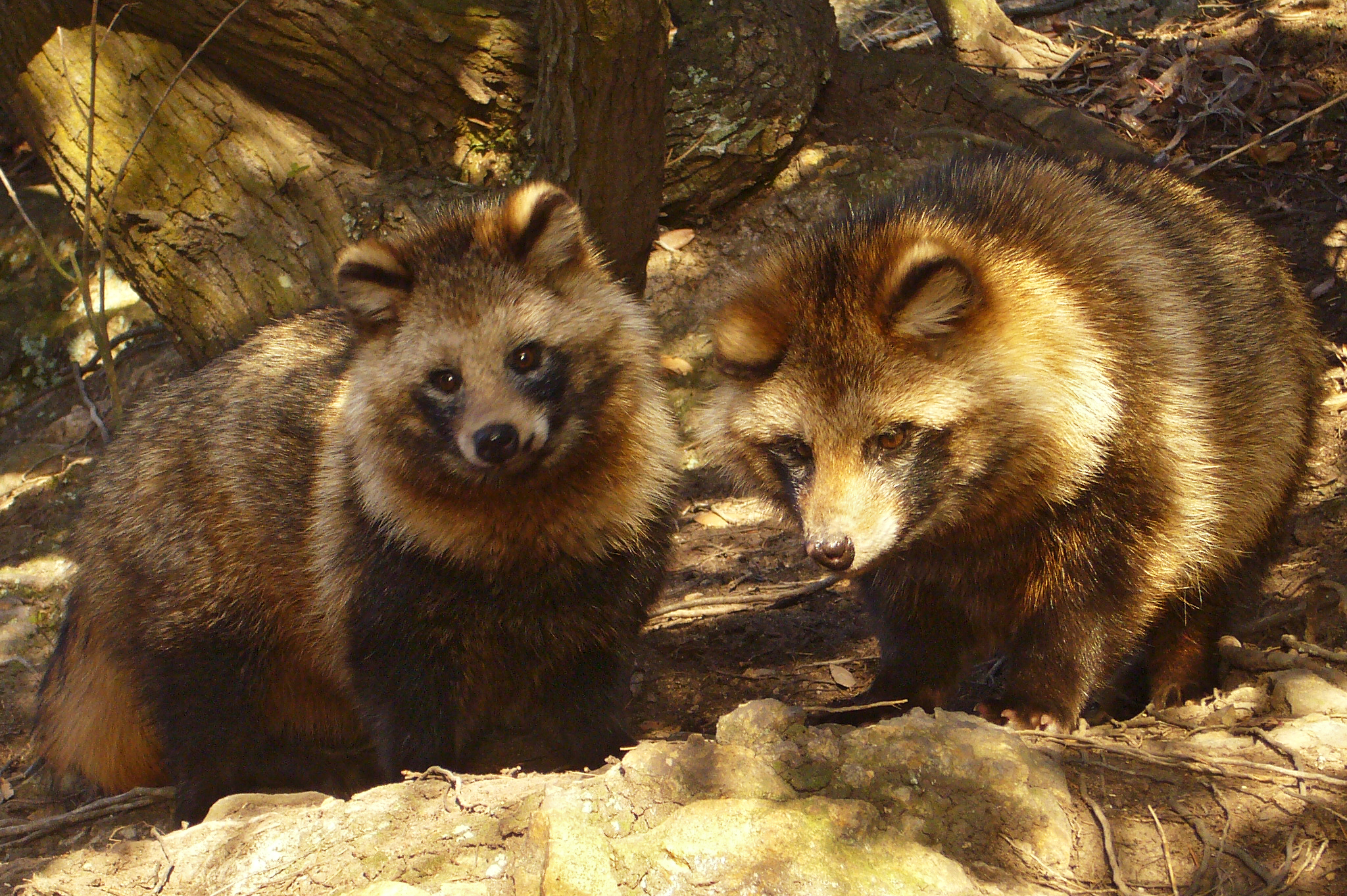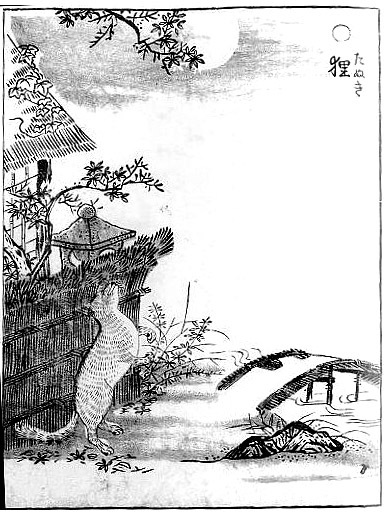|
Mujina
is an old Japanese term primarily referring to the Japanese badger, but traditionally to the Japanese raccoon dog (''tanuki''), causing confusion. Adding to the confusion, it may also refer to the introduced masked palm civet, and in some regions badger-like animals or Japanese raccoon dog are also called ''mami''. Appearance The ''mujina'' is said to be a raccoon-faced creature in its natural form, with the main body being that of a Japanese badger. In some parts of Japan, they are incorrectly referred to as the ''tanuki'', with whom they are closely related to in terms of appearance as well as actions- even though the ''tanuki'' are biologically related to the fox and dog.Reeves, David. “A Brief Introduction to Aoki Rosui and Annotated Translation of his Text Otogi Hyaku Monogatari.” ''Masters Theses'', 240, 2015, pp. 37-40. https://doi.org/10.7275/7012662. Accessed 25 Nov 2022. The ''mujina'' in specific are known to be able to inflate their bellies, creating music by ... [...More Info...] [...Related Items...] OR: [Wikipedia] [Google] [Baidu] |
Noppera-bō
The , or faceless ghost, is a Japanese yōkai that looks like a human but has no face. They are sometimes mistakenly referred to as a ''mujina'', an old Japanese word for a badger or raccoon dog. Although the ''mujina'' can assume the form of the other, ''noppera-bō'' are usually disguised as humans. Such creatures were thought to sometimes transform themselves into ''noppera-bō'' in order to frighten humans. Lafcadio Hearn used the animals' name as the title of his story about faceless monsters, probably resulting in the misused terminology. ''Noppera-bō'' are known primarily for frightening humans, but are usually otherwise harmless. They appear at first as ordinary human beings, sometimes impersonating someone familiar to the victim, before causing their features to disappear, leaving a blank, smooth sheet of skin where their face should be. In legends Often, a ''noppera-bō'' would not actually exist, but was the disguise of a ''mujina'', a fox ''kitsune'', or a ''tanuki'' ... [...More Info...] [...Related Items...] OR: [Wikipedia] [Google] [Baidu] |
Noppera-bō
The , or faceless ghost, is a Japanese yōkai that looks like a human but has no face. They are sometimes mistakenly referred to as a ''mujina'', an old Japanese word for a badger or raccoon dog. Although the ''mujina'' can assume the form of the other, ''noppera-bō'' are usually disguised as humans. Such creatures were thought to sometimes transform themselves into ''noppera-bō'' in order to frighten humans. Lafcadio Hearn used the animals' name as the title of his story about faceless monsters, probably resulting in the misused terminology. ''Noppera-bō'' are known primarily for frightening humans, but are usually otherwise harmless. They appear at first as ordinary human beings, sometimes impersonating someone familiar to the victim, before causing their features to disappear, leaving a blank, smooth sheet of skin where their face should be. In legends Often, a ''noppera-bō'' would not actually exist, but was the disguise of a ''mujina'', a fox ''kitsune'', or a ''tanuki'' ... [...More Info...] [...Related Items...] OR: [Wikipedia] [Google] [Baidu] |
Japanese Raccoon Dog
The Japanese raccoon dog (''Nyctereutes viverrinus''), also known as the ''tanuki'' ( ja, , , ), is a species of canid endemic to Japan. It is one of two species in the genus ''Nyctereutes'', alongside the common raccoon dog (''N. procyonoides''), of which it was formerly thought to be a subspecies. The Japanese raccoon dog has a relatively smaller stomach and shorter fur of lesser insulation value than mainland raccoon dogs. A rare, white colour type can also be found. Within Japanese folklore, the ''tanuki'' have had a significant role since ancient times. The legendary ''tanuki'' are reputed to be mischievous and jolly, masters of disguise and shapeshifting but somewhat gullible and absentminded. The animals have also been common in Japanese art, particularly as subjects for statues. Japanese etymology While ''tanuki'' are prominent in Japanese folklore and proverbs, they were not always clearly distinguished from other animals with a similar appearance. In local dialects, '' ... [...More Info...] [...Related Items...] OR: [Wikipedia] [Google] [Baidu] |
Japanese Badger
The Japanese badger (''Meles anakuma'') is a species of carnivoran of the family Mustelidae, the weasels and their kin. Endemic to Japan, it is found on Honshu, Kyushu, Shikoku, and Shōdoshima. It shares the genus '' Meles'' with its close relatives, the European (''M. meles'') and Asian (''M. leucurus'') badgers. In Japan it is called by the name ''anaguma'' (穴熊) meaning "hole-bear", or ''mujina'' (むじな, 狢). Description Japanese badgers are generally smaller (average length in males, in females) and less sexually dimorphic (except in the size of the canine teeth) than their European counterparts. Tail length is between . This species is similar or mildly larger than the Asian badger. Adults usually weigh from . The average weight of female Japanese badgers in one study from the Tokyo area was found to be while that of males was . In the Yamaguchi Prefecture, the average spring weight of female and male Japanese badgers was and .Tanaka, H. 2002. ''Ecology and So ... [...More Info...] [...Related Items...] OR: [Wikipedia] [Google] [Baidu] |
Bake-danuki
''Bake-danuki'' () are a kind of ''yōkai'' (supernatural beings) found in the classics and in the folklore and legends of various places in Japan, commonly associated with the Japanese raccoon dog or ''tanuki''. Although the ''tanuki'' is a real, extant animal, the ''bake-danuki'' that appears in literature has always been depicted as a strange, even supernatural animal. The earliest appearance of the ''bake-danuki'' in literature, in the chapter about Empress Suiko in the '' Nihon Shoki'' written during the Nara period, there are such passages as "in two months of spring, there are tanuki in the country of Mutsu (), they turn into humans and sing songs ()." Bake-danuki subsequently appear in such classics as the Nihon Ryōiki and the Uji Shūi Monogatari. In some regions of Japan, ''bake-danuki'' are reputed to have abilities similar to those attributed to ''kitsune'' (foxes): they can shapeshift into other things or people, and can possess human beings. Many legends of ''tanuk ... [...More Info...] [...Related Items...] OR: [Wikipedia] [Google] [Baidu] |
Glen Grant (historian)
Glen Grant (February 23, 1947 – June 19, 2003) was a Hawaiian historian, author and folklorist. He was primarily known for his Obake Files, a collection of articles and stories regarding native and imported folktales and mythology in Hawaii. Grant was also the author of the Chicken Skin series of ghost story anthologies, as well as host of the long-running radio show of the same name. Life Grant was born and raised in the west Los Angeles area near Palms and Culver City. He was the son of Hollywood special effects wizard Cliff Grant, who worked on such films as ''Gone with the Wind'', '' The Wizard of Oz'' and ''Forbidden Planet.'' The elder Grant helped create the extraterrestrial robot Gort from ''The Day the Earth Stood Still'' and Robby the Robot from ''Forbidden Planet''. "Robby eventually became a member of the Grant household, where the younger Grant said he would see the robot, stashed in the family garage, on a daily basis. Though the robot ultimately ended up in a ... [...More Info...] [...Related Items...] OR: [Wikipedia] [Google] [Baidu] |
Shapeshifter
In mythology, folklore and speculative fiction, shape-shifting is the ability to physically transform oneself through an inherently superhuman ability, divine intervention, demonic manipulation, sorcery, spells or having inherited the ability. The idea of shape-shifting is in the oldest forms of totemism and shamanism, as well as the oldest existent literature and epic poems such as the ''Epic of Gilgamesh'' and the ''Iliad''. The concept remains a common literary device in modern fantasy, children's literature and popular culture. Folklore and mythology Popular shape-shifting creatures in folklore are werewolves and vampires (mostly of European, Canadian, and Native American/early American origin), ichchadhari naag and ichchadhari naagin (shape-shifting cobras) of India, the huli jing of East Asia (including the Japanese ''kitsune'' and Korean ''kumiho''), and the gods, goddesses, and demons and demonesses like succubus and incubus and other numerous mythologies, ... [...More Info...] [...Related Items...] OR: [Wikipedia] [Google] [Baidu] |
Kāhala, Hawaii
Kāhala, is a neighborhood in Honolulu, Hawaii. Kahala contains a large concentration of expensive real estate and beachfront properties, which include some of the most expensive in the entire state. Kahala consists of approximately 1,200 homes. The neighborhood is considered a “cinderella story” because it went from farmland to one of the nicest neighborhoods on Oahu. Kahala is also home to the Kahala Hotel & Resort, formerly known as the Kahala Mandarin Oriental, and prior to the Kahala Hilton. Also located along the borders are Kahala Mall, and Diamond Head crater. There are a variety of residents of many ages, the newer arrivals to the island generally own the more modern and spacious homes, though many of the older homes are beautiful and finely aged. Many celebrities and Business persons have also bought vacation homes in the area. Kahala is a favored spot for investors to purchase and renovate homes to sell. In 2006, typical prices for a house in Kahala ranged fr ... [...More Info...] [...Related Items...] OR: [Wikipedia] [Google] [Baidu] |
Ghost
A ghost is the soul or spirit of a dead person or animal that is believed to be able to appear to the living. In ghostlore, descriptions of ghosts vary widely from an invisible presence to translucent or barely visible wispy shapes, to realistic, lifelike forms. The deliberate attempt to contact the spirit of a deceased person is known as necromancy, or in spiritism as a ''séance''. Other terms associated with it are apparition, haunt, phantom, poltergeist, shade, specter or spectre, spirit, spook, wraith, demon, and ghoul. The belief in the existence of an afterlife, as well as manifestations of the spirits of the dead, is widespread, dating back to animism or ancestor worship in pre-literate cultures. Certain religious practices—funeral rites, exorcisms, and some practices of spiritualism and ritual magic—are specifically designed to rest the spirits of the dead. Ghosts are generally described as solitary, human-like essences, though stories of ghostly armies and th ... [...More Info...] [...Related Items...] OR: [Wikipedia] [Google] [Baidu] |
Honolulu Advertiser
''The Honolulu Advertiser'' was a daily newspaper published in Honolulu, Hawaii. At the time publication ceased on June 6, 2010, it was the largest daily newspaper in the American state of Hawaii. It published daily with special Sunday and Internet editions. ''The Honolulu Advertiser'' was the parent publisher of ''Island Weekly'', ''Navy News'', ''Army Weekly'', ''Ka Nupepa People'', ''West Oahu People'', ''Leeward People'', ''East Oahu People'', ''Windward People'', ''Metro Honolulu People'', and ''Honolulu People'' small, community-based newspapers for the public. ''The Honolulu Advertiser'' has had a succession of owners since it began publishing in 1856 under the name the ''Pacific Commercial Advertiser''. On February 25, 2010, Black Press, which owned the '' Honolulu Star-Bulletin'', purchased ''The Honolulu Advertiser'' from Gannett Pacific Corporation, which acquired the ''Advertiser'' in 1992 after it had sold the ''Star-Bulletin'' to another publisher that later sold ... [...More Info...] [...Related Items...] OR: [Wikipedia] [Google] [Baidu] |
:Category:Japanese Words And Phrases ...
{{Commons Words and phrases by language Words Words Words A word is a basic element of language that carries an objective or practical meaning, can be used on its own, and is uninterruptible. Despite the fact that language speakers often have an intuitive grasp of what a word is, there is no consen ... [...More Info...] [...Related Items...] OR: [Wikipedia] [Google] [Baidu] |
Nervous Breakdown
A mental disorder, also referred to as a mental illness or psychiatric disorder, is a behavioral or mental pattern that causes significant distress or impairment of personal functioning. Such features may be persistent, relapsing and remitting, or occur as single episodes. Many disorders have been described, with signs and symptoms that vary widely between specific disorders. Such disorders may be diagnosed by a mental health professional, usually a clinical psychologist or psychiatrist. The causes of mental disorders are often unclear. Theories may incorporate findings from a range of fields. Mental disorders are usually defined by a combination of how a person behaves, feels, perceives, or thinks. This may be associated with particular regions or functions of the brain, often in a social context. A mental disorder is one aspect of mental health. Cultural and religious beliefs, as well as social norms, should be taken into account when making a diagnosis. Services are ... [...More Info...] [...Related Items...] OR: [Wikipedia] [Google] [Baidu] |


.jpg)



